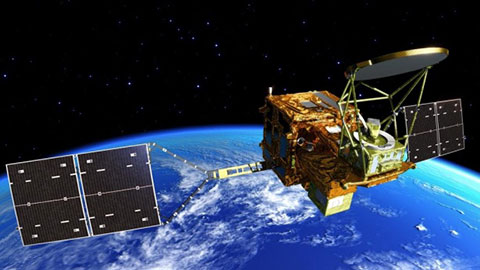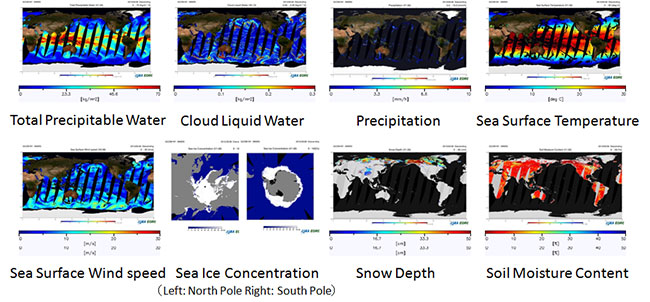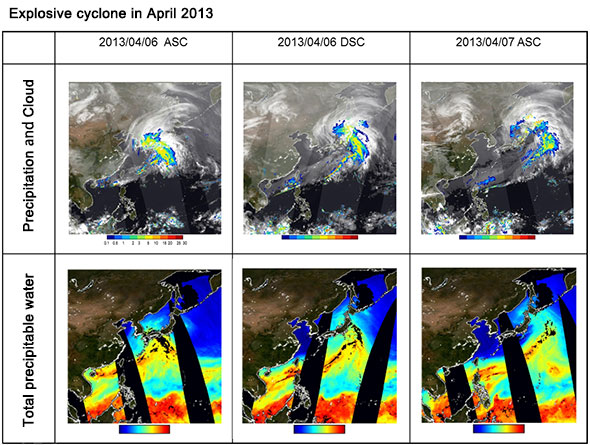SHIZUKU (GCOM-W1)
to Provide Geophysical Quantity Products
Japan Aerospace Exploration Agency (JAXA)
The Japan Aerospace Exploration Agency (JAXA) has started offering eight kinds of products whose physical quantity concerning water on the Earth, including precipitable water and sea surface temperature, is calculated based on the observation data acquired by the Advanced Microwave Scanning Radiometer 2 (AMSR2) aboard the Global Change Observation Mission 1st – Water “SHIZUKU” (GCOM-W1) after its initial calibration operation*1 was completed. The SHIZUKU was launched on May 18, 2012.
These products will contribute to capture environmental changes on a global scale such as worrisome decreasing ocean ice areas in the North Pole as well as the El Nino and La Nina Phenomena. The products can also be utilized for various fields including weather and precipitation forecasts for storms and downpours by global meteorological agencies such as the Japan Meteorological Agency and the National Oceanic and Atmospheric Administration (NOAA) of the U.S., compiling fishing and oceanographic conditions for efficiently finding fishing points by the Japan Fisheries Information Service Center, and enhancing measures against floods in Asian countries that engage in a cooperative project with the Asian Development Bank.
*1 Calibration operation: To improve accuracy, Earth physical quantity acquired through data obtained by the SHIZUKU, including precipitable water and ocean surface temperature, are compared with data acquired through other independent methods such as observations on the ground.
[How to receive data]
Please register at the following SHIZUKU data provision website:
https://gcom-w1.jaxa.jp
After registering, you can download brightness temperature products.
We began providing brightness temperature products on January 25, 2013 at the following website.
http://www.jaxa.jp/press/2013/01/20130125_shizuku_e.html

For more about the SHIZUKU, please refer to the following JAXA Satellite Applications Mission Directorate I website:
http://www.jaxa.jp/projects/sat/gcom_w/index_e.html
|
|
Attachments: SHIZUKU AMSR2 Standard Products
JAXA offers “brightness temperature products” and “Earth physical quantity products” to the general public as standard products acquired from data observed by the AMSR2 aboard the SHIZUKU. The brightness temperature products indicate radio wave strength of a specific frequency emitted from the ground and the atmosphere. The Earth physical quantity products are a physical quantity concerning water on the Earth generated through calculations based on input data of brightness temperature products. The following table 1 shows the overview of SHIZUKU’s standard productsTable 1: SHIZUKU Standard Products
| Products | Target Fields | Spatial Resolution | |
| Bright temperature (6 frequencies/2 polarized waves) |
Across the globe | 5-50km | |
| Earth Physical Quantity | Total precipitable water | Global oceans | 15km |
| Cloud liquid water | Global oceans | 15km | |
| Precipitation | Tropics to temperate regions | 15km | |
| Sea surface temperature | Global oceans | 50km | |
| Sea surface wind speed | Global oceans | 15km | |
| Sea ice concentration | Oceans in high latitudes | 15km | |
| Snow depth | Terrestrial | 30km | |
| Soil moisture content | Terrestrial | 50km | |
(1) Brightness temperature products:
The AMSR2 measures the strength of microwaves in six frequencies between 7 GHz and 89 GHz emitted from the ground and the atmosphere. In the 7 GHz bandwidth, the AMSR2 has two receiver systems for the frequencies of 6.925 GHz and 7.3 GHz, and it is also equipped with a two receiver system called system A and B in the 89 GHz bandwidth.
Each frequency/system can measure vertical polarization and horizontal polarization, thus the AMSR2 can offer 16 different kinds of brightness temperature products. The following Table 2 is the AMSR2's major characteristics, and Figure 1 shows some examples of brightness temperature products.
JAXA completed the calibration for enhancing measurement accuracy (bright temperature accuracy) by adjusting observation devices and ground data processing software through evaluation of data measured by the AMSR2, the onboard observation device of the SHIZUKU. Following the calibration completion, we started providing the products on July 25, 2013.
Brightness temperature products are used as input data to generate earth physical quantity products, and will also be utilized for weather related operations by meteorological agencies all over the world such as the Japanese Meteorological Agency and the National Oceanic and Atmospheric Administration (NOAA) of the U.S.
Table 2: AMSR2 Major Characteristics
| Observation frequency (GHz) | 6.925 | 7.3 | 10.65 | 18.7 | 23.8 | 36.5 | 89.0(A) | 89.0(B) |
| Observation polarization | Vertical and horizontal polarizations | |||||||
| Measuring range (K) | 2.7 - 340 | |||||||
| Temperature resolution (K) | 0.34 | 0.43 | 0.7 | 0.7 | 0.6 | 0.7 | 1.2 | 1.2 |
| Instantaneous view angle (Az×El) | 35×62 | 34×58 | 24×42 | 14×22 | 15×26 | 7×12 | 3×5 | 3×5 |
| Measurement width (km) | 1450 | |||||||

Figure 1: Examples of Brightness Temperature Products (on ascending orbit on Jan. 18, 2013)
(2) Physical quantity products of the Earth
Some brightness temperatures in a certain frequency differ according to physical objects and conditions of the ground and the atmosphere where radio waves are emitted. Thus, we can calculate the physical quantity of the Earth such as sea surface temperatures by combining brightness temperature information in several frequencies. Figure 2 below indicates which brightness temperature products generated by the AMSR2 are used for eight earth physical quantity products (total precipitation water, cloud liquid water, precipitation, sea surface temperature, sea surface wind speed, sea ice concentration, snow depth, and soil moisture content.) For example, a 6.925 GHz brightness temperature product that is sensitive to the sea surface temperature is mainly used for finding such a temperature while correcting the impact of atmospheric vapor using 23.8 GHz and 36.5 GHz brightness temperature products.
The Earth physical quantity products acquired by the SHIZUKU have been under the evaluation process of comparing them with the products measured by other observation methods on the ground including a radiosonde and ocean buoy. As we completed the process, we started offering earth physical quantity products today as scheduled, about a year after the launch of the SHIZUKU.
The products are expected to be useful in various areas such as monitoring sea ice areas in the North Pole, compiling information on fishing conditions for understanding fishery activities, studying droughts and floods, and for application in the agriculture sector.

Figure 2: Relation between AMSR2 Brightness Temperature Products (6.925 - 89.0GHz) and Earth Physical Quantity Products

Figure 3: Examples of Earth physical quantity products (On descending orbit on May 8, 2013)
